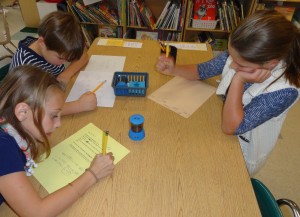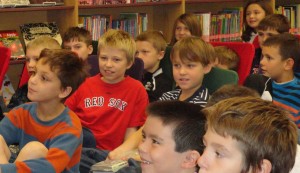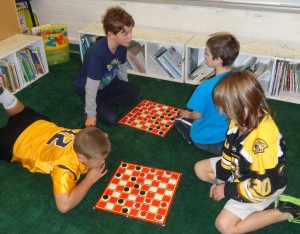With the final questionnaire and the final make up test Friday morning, 3E will have successfully completed the NECAP testing program for 2012. They worked very hard. You would be proud of their effort and surprised, both, at what they know and what they don’t understand. The language of the test is challenging – if it’s greater than 25 but fewer than 75, children wondered “do you count the 25 that is one of the choices or not”, “figures”, “shade in” and “congruent” were among the challenges to deal with and your children did their best. Thank you again to the families who sent in snacks this week. We enjoyed them very much. I think most of the children would say the NECAP’s were not that bad and some would say they were fun. It will be nice to be back into our routine and see what we can get done.
Numbers of the Week
 This week we began a new exploration of numbers. Our numbers of the week were 33 and 288. They were chosen because Monday, October 15 was our thirty-third day of school and the two hundred and eighty eighth day of the year. Each day this week we did something different with those amounts. We learned the standard, expanded and work forms. We learned about generating patterns that were 10 terms long. We learned about rounding off and using estimation to check accuracy of answers. We learned about sums and differences and the children worked to develop their own problems to solve that made them think.
This week we began a new exploration of numbers. Our numbers of the week were 33 and 288. They were chosen because Monday, October 15 was our thirty-third day of school and the two hundred and eighty eighth day of the year. Each day this week we did something different with those amounts. We learned the standard, expanded and work forms. We learned about generating patterns that were 10 terms long. We learned about rounding off and using estimation to check accuracy of answers. We learned about sums and differences and the children worked to develop their own problems to solve that made them think.
Through the numbers of the week we are trying to understand that they are amounts with meaning. When children read C-A-T they see more than the three letters, but when children see 1-2-3 they do not always see more than a count. We are trying to give the children the tools they need to think about and understand how they are working with amounts rather than training them to do rote procedures. Hopefully the children will begin to see that numbers are richer than symbols on a paper and that one number can be studied and looked at in many different ways.
This week we introduced the daily routines and hopefully in another week all of the children will understand the meaning of the steps and will be working to explore the complexities of numbers and mathematics.
understand the meaning of the steps and will be working to explore the complexities of numbers and mathematics.
(Next week’s numbers will be 277 and 37, 416 – Steve Cotler told us that these are the number of pages and words in Cheesie Mack.)
Thinking about How Respect Shows
SEL – working on social awareness and self-management
This week we began tackling “RESPECT” and working to understand how and why it matters. Being respectful is one of our classroom rules. The children are very good at talking about it but not great at following through as a class. Many of the children are always respectful. They want to do well and they want others to do well. They know the times to be silly and the times to listen. They know the times to share ideas and the times to keep their thought inside. They know how to make choices that consider themselves and others. They know how to move safely and with consideration. Others, more than half of our class, do not act in these ways or make these choices. They want to feel good and do well, but they don’t yet realize the impact of their choices on either themselves or others. When a thought occurs to them they blurt it out whether it adds to the learning or not. If they feel the need to have a conversation they do regardless of how it stops others from working, keeps them from working or interrupts a lesson. If they can do something to make someone else laugh, than being funny is a first choice. Shouting or running in the hall, yelling while others are working, ripping erasers out of pencils are seen as okay because “we’re just kids.” They would feel comfortable saying they were writing even though they had chatted for 30 minutes and wrote 5 or 10 word because their writer’s notebook had been open in front of them.
It is true they are children but it is also true that each individual chooses his or her behavior, attitude and effort. We are working to consider choices more closely. You might want to ask your son or daughter how they think they are doing in showing respectful behavior. Are they aware if they are following our rules and meeting the expectations of the classroom? When they leave the rug after a lesson, do they usually know how to get started on the work? Do they notice directions or feedback so they can do better? Do they focus more on the assignments or on talking about the assignments? If they are talking, do they think about keeping their voices are low or do they fill the room? Do they use time well? Many of the children are not aware of how they are impacting others. We’ll keep working on this to see if we can make the atmosphere of our classroom more purposeful and productive without losing any of the energy and fun.
Bits and Pieces – you might want to ask your child about:
Mysteries According to Humphrey – our 4th completed chapter read aloud this year,
the importance of a 1909 penny or the Mouse Plot,
learning the qualities of a good paragraph, or
what he or she is reading and writing each day.
